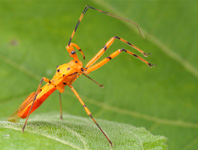Abstract
A new whipray, Maculabatis ambigua sp. nov., described from material collected from the Red Sea and off Zanzibar (Tanzania), is probably more widespread in the northwestern Indian Ocean. It has been confused with other Indian Ocean whiprays of the genus Maculabatis (formerly Himantura in part) i.e. M. gerrardi and M. randalli. Maculabatis ambigua sp. nov. was first distinguished from these species by molecular analysis, and subsequently by a combination of morphological characters, i.e. disc shape, coloration, morphometrics and squamation. Molecular data suggest that it is most closely related to the morphologically similar M. gerrardi, which occurs further east in the Indian Ocean (Oman to Indonesia) and North-West Pacific (north to Taiwan). The dorsal disc of M. gerrardi typically has a full or partial coverage of white spots (usually present at least on the posterior disc), whereas M. ambigua sp. nov. is plain coloured. Maculabatis randalli, which occurs in the Persian and Arabian Gulfs, is plain coloured, but has a longer disc relative to its width, more acute and longer snout, longer head and larger intergill width, wider internasal distance, and a narrower secondary denticle band in adults. Maculabatis ambigua sp. nov. is relatively common in the shallow, soft-sedimentary habitats of the southern Red Sea from where it is taken as low-value or discarded bycatch of trawl fisheries. It is a medium-sized whipray with a maximum confirmed size of 840 mm disc width.
References
Bleeker, P. (1852) Bijdrage tot de kennis der Plagiostomen van den Indischen Archipel. Verhandelingen van het Bataviaasch Genootschap van Kunsten en Wettenschappen, 24 (12), 1–92.
Bogorodsky, S.V., Alpermann, T.J., Mal, A.O. & Gabr, M.H. (2014) Survey of demersal fishes from southern Saudi Arabia, with five new records for the Red Sea. Zootaxa, 3852 (4), 401–437.
http://dx.doi.org/10.11646/zootaxa.3852.4.1Compagno, L.J.V. (1999) Technical terms and measurements. In: Carpenter, K.E. & Niem, V.H. (Ed.), FAO species identification guide for fishery purposes. The living marine resources of the Western Central Pacific. Volume 3 Batoid fishes, chimaeras and bony fishes part 1(Elopidae to Linophrynidae). FAO, Rome. pp. 1398.
Compagno, L.J.V. & Heemstra, P.C. (1984) Himantura draco, a new species of stingray (Myliobatiformes: Dasyatidae) from South Africa, with a key to the Dasyatidae and the first record of Dasyatis kuhlii (Müller & Henle, 1841) from southern Africa. J.L.B. Smith Institute of Ichthyology Special Publication, 33, 1–17.
Compagno, L.J.V. & Roberts, T.R. (1982) Freshwater stingrays (Dasyatidae) of Southeast Asia and New Guinea, with description of a new species of Himantura and reports of unidentified species. Environmental Biology of Fishes, 7 (4), 321–339.
http://dx.doi.org/10.1007/BF00005567Dor, M. (1984) Checklist of the Fishes of the Red Sea. Israel Academy of Sciences and Humanities, Jerusalem, xxi + 427 pp.
Fricke, R. & Eschmeyer, W.N. (2016) Guide to fish collections. Available from: http://researcharchive.calacademy.org/research/ichthyology/catalog/collections.asp (accessed 17 Jun 2016)
Gohar, H.A.F. & Mazhar, F.M.M. (1964) The elasmobranchs of the north-western Red Sea. Publications Marine Biological Station Al Ghardaqa, 13, 1–144.
Golani, D. & Bogorodsky, S.V. (2010) The fishes of the Red Sea – reappraisal and updated checklist. Zootaxa, 2463, 1–135.
Goren, M. & Dor, M. (1994) An updated checklist of the fishes of the Red Sea. CLOFRES II. The Israel Academy of Sciences and Humanities, Jerusalem, 120 pp.
Gray, J.E. (1851) List of the specimens of fish in the collection of the British Museum. Part I. Chondropterygii. British Museum of Natural History, London. 160 pp.
Jordan, D.S. & Seale, A. (1906) The fishes of Samoa. Description of the species found in the archipelago, with a provisional check-list of the fishes of Oceania. Bulletin of the Bureau of Fisheries, 25, 173–455.
Klunzinger, C.B. (1871) Synopsis der Fische des Rothen Meeres. II. Theil. Verhandlungen der K.-K. zoologisch-botanischen Gesellschaft in Wien, 21, 441–688.
Last, P.R. & Stevens, J.D. (1994) Sharks and Rays of Australia. CSIRO, Australia, 1–513, col. pls. 1084.
Last, P.R., Manjaji-Matsumoto, M. & Kailola, P.J. (2006) Himantura hortlei n. sp., a new species of whipray (Myliobatiformes: Dasyatidae) from Irian Jaya, Indonesia. Zootaxa, 1239, 19–34.
Last, P.R., Manjaji-Matsumoto, M. & Moore, A.B.M. (2012) Himantura randalli sp. nov., a new whipray (Myliobatoidea: Dasyatidae) from the Persian Gulf. Zootaxa, 3327, 20–32.
Last, P.R., Manjaji-Matsumoto, B.M. & Pogonoski, J.J. (2008) Himantura astra sp. nov., a new whipray (Myliobatoidei: Dasyatidae) from northern Australia. In: Last, P.R., White, W.T. & Pogonoski, J.J. (Eds.), Descriptions of new Australian Chondrichthyans. CSIRO Marine & Atmospheric Research Paper 022, pp. 303–314.
Last, P.R., Naylor G.J.P. & Manjaji-Matsumoto, B.M. (2016) A revised classification of the family Dasyatidae (Chondrichthyes: Myliobatiformes) based on new morphological and molecular insights. Zootaxa, 4139 (3), 345–368.
http://dx.doi.org/10.11646/zootaxa.4139.3.2Manjaji, B.M. (2004) Taxonomy and phylogenetic systematics of the Indo–Pacific Whip-Tailed Stingray genus Himantura Müller & Henle 1837 (Chondrichthyes: Myliobatiformes: Dasyatidae). Unpublished PhD Thesis Dissertation, University of Tasmania. 607 pp.
Müller, J. & Henle, F.G.J. (1837) Ueber die Gattungen der Plagiostomen. Archiv für Naturgeschichte, 3, 394–401, 434.
http://dx.doi.org/10.5962/bhl.part.10051Whitley, G.P. (1939) Taxonomic notes on sharks and rays. Australian Zoologist, 9 (3), 227–262.

